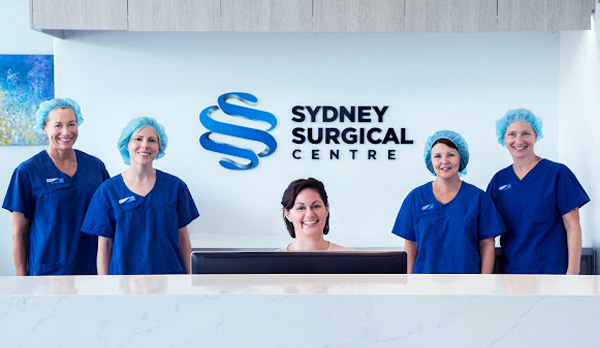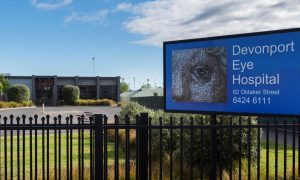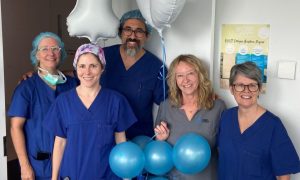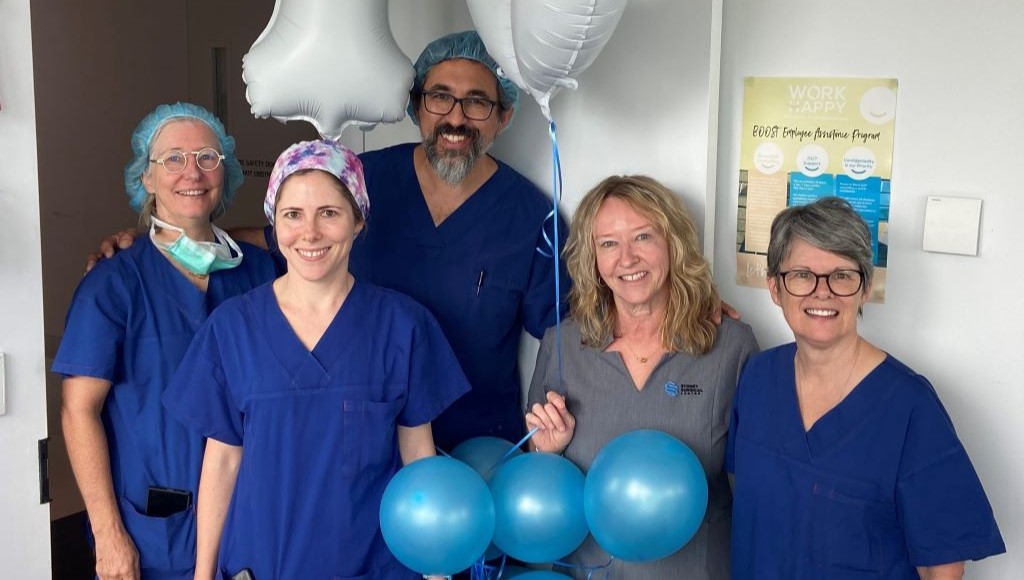Welcome to Sydney Surgical Centre
Sydney Surgical Centre was established in April 2015 and is a fully licensed and accredited private hospital specialising in the provision of first class patient treatment with three large state-of-the-art integrated operating suites for both adult and child patients. This specially designed hospital is fully equipped with the latest and most advanced medical equipment and instrumentation to meet the unique needs of the array of advanced surgical specialties we offer.

- Patient Information
- Find a Doctor
- Patient Feedback
- Australian Charter of Healthcare Rights
- Patient Safety and Quality
- Governance
- Online admissions
- Our Procedures
Carpal tunnel release is a surgery used to treat carpal tunnel syndrome. There are two types of Carpal Tunnel Release Surgery; Endoscopic and Open.
Endoscopic carpal tunnel release surgery is the use of an endoscope to cut the transverse carpal ligament. The endoscope is usually inserted through a small incision in the palm.
During the open surgery, the surgeon will cut the carpal ligament to relieve pressure on the median nerve, and make more space for the nerve and tendons.
Laparoscopic hernia surgery is a surgical procedure in which a laparoscope is inserted into the abdomen through a small incision to repair the hernia.
Open hernia repair is the procedure performed to repair hernia by pushing the hernia back in place through an abdominal incision.
Surgical removal of lesions is a simple procedure undertaken to remove growths such as lesions, tumours or moles for either medical or cosmetic reasons.
Lipomas are fatty lumps that develop under your skin. Most lipomas are harmless and don’t need to be removed.
Surgery is sometimes used to remove lipomas for cosmetic reasons or if they’re causing pain. It’s rare for lipomas to return after surgery.
Lipoma removal is usually a simple procedure. Here’s a general idea of what you can expect:
- A local anesthetic is injected around the lump to numb the area.
- Your doctor will make a cut in your skin over the lipoma.
- They’ll then remove the lipoma and stitch the wound.
Your surgery will likely take less than an hour and possibly less than half an hour.
Usually, the incision will be about the width of the lipoma. Your surgeon may also perform the squeeze technique. During this variation, the lipoma is pushed through a smaller incision. The squeeze technique can help minimize scarring, but it’s often ineffective for larger lipomas.
Wedge resection toenail is the surgical treatment for an ingrown toenail.
A blepharoplasty is a procedure which removes excess or sagging skin from upper and/or lower eyelids. The surgery is usually performed for cosmetic reasons however; it can improve sight in patients whose eyelids are obscuring their vision.
A canthoplasty is a surgical procedure that tightens the area around the eye in order to correct a drooping appearance, and create an upward slant in the outer corner of the eye.
A chalazion is a lump on the eyelid that is usually caused by obstruction of the drainage duct of an oil gland within the upper or lower eyelid. Surgical removal of chalazion may become necessary if vision becomes obscured, or an astigmatism.
A Dacryocystorhinostomy (DCR) is an operation performed to unblock the nasolacrimal duct (tear duct).
Ectropion is a medical condition where the eyelid folds outward. Corrective surgery involves the removal of a small piece of the fold to tighten the muscles in the area.
Excision of lesions is a procedure to remove growths such as lesions, moles and tumours from the skin, sometimes accompanied by frozen sections and followed by sutures or a graft. The most common reason for undertaking this procedure is for the removal of skin cancers such as Basal Cell Carcinoma which is the most common skin cancer on the face.
Ptosis is a drooping of the upper eyelid. Corrective surgery is performed by tightening the levator muscle through an incision in the normal crease in the upper lid.
A wedge excision is a procedure which removes cancers from the edge of the eyelid.
Cataract surgery is the surgical replacement of a cloudy lens with an artificial intraocular lens (IOL) implant to restore vision. The cloudy lens is broken up and removed with an ultrasound probe through a very small incision in the eye, and the artificial lens is inserted.
Vitrectomy is a surgery which removes the vitreous gel from the eye to assist in the repair of retinal detachments, macular holes and retinal membrane surgeries.
An apicoectomy is a straightforward, minor surgical procedure that’s done on children and adults as a way to save at-risk teeth and prevent potentially serious complications.
An apicoectomy is also known as root end surgery. This is because it involves the removal of a tooth’s root tip and surrounding tissue. It’s also called apical surgery, which refers to the “apex,” or end, of the tooth.
If your health professional tells you that you need an apicoectomy, it’s probably because even though your tooth has already had a root canal, there’s residual inflammation or infection near the root tip that reaches into your jawbone.
A biopsy is a procedure where a small piece of tissue is removed from an area so that it can be looked at closely under a microscope.
Bone augmentation for dental implants are sometimes necessary when a patient does not have enough bone available to properly anchor the screw or other implant hardware. Dental bone augmentation includes a variety of procedures, including sinus lifts, bone graft procedures, and manipulation of bone using an osteotome or osteotome mallet. Since an implant cannot be done without a certain amount of bone available, it becomes necessary for a periodontal surgeon to stimulate the patient to grow more bone in the area, or to remove bone from one area and place it in the area where the implant will be done.
Bone augmentation is not uncommon during dental implant procedures especially in cases of bone atrophy, where tooth loss without replacement has caused the deterioration of bone over time. Bone augmentation surgery can be done to improve the likelihood of being able to place an implant, but it does require implant surgery to be delayed while the bone heals.
Dental implants are used to replace damaged or missing teeth. A dental implant procedure is where a screw or metal fixture is implanted into the jaw as the base for a new false tooth.
An upper jaw, or maxillary, torus presents as a bony lump in the middle of the palate. Lower jaw, or mandibular, tori present as bony lumps on the right and left of the jaw, along the surface that abuts the tongue, near the premolar teeth.
Sinus lift surgery is a treatment approach your dentist may recommend when you desire dental implants but don’t have enough jaw bone to secure the implant.
Other names for this procedure include sinus augmentation or sinus graft. Several kinds of medical specialists may perform this procedure, such as a periodontists or oral surgeons.
There are lots of techniques that a dental specialist can use to perform sinus lift surgery. Keep reading to find out more about these approaches and how they may help secure your dental implants.
When wisdom teeth have the potential to cause problems or become impacted, they may be removed surgically. In the procedure, the surgeon makes a small incision and extracts the tooth with forceps.
The temporomandibular joint (TMJ) is the hinge-like joint which joins the jaw to the skull. TMJ dysfunction typically occurs as a result of arthritis or jaw related injury. TMJ disorders are usually managed through arthrocentesis and injections.
A tooth extraction is the removal of a tooth from the dental alveolus (socket) in the alveolar bone.
Ankle arthroscopy is a minimally invasive surgical procedure that Orthopaedic surgeons use to treat problems in the ankle joint. Ankle arthroscopy uses a thin fiber-optic camera (arthroscope) that can magnify and transmit images of the ankle to a video screen. Ankle arthroscopies can reduce ankle pain and improve overall function.
Arthroscopy can be used to diagnose and treat different disorders of the ankle joint. The list of problems that can sometimes be treated with this technology is constantly evolving and includes:
- Ankle arthritis: Ankle fusion is a treatment option for many patients with end-stage ankle arthritis. Ankle arthroscopy offers a minimally invasive way to perform ankle fusion. Results can be equal to or better than open techniques.
- Ankle fractures: Ankle arthroscopy may be used along with open techniques of fracture repair. This can help to ensure normal alignment of bone and cartilage. It also may be used during ankle fracture repair to look for cartilage injuries inside the ankle.
- Ankle instability: Ligaments of the ankle can become stretched out, which can lead to a feeling that the ankle “gives out.” These ligaments can be tightened with surgery. Arthroscopic techniques may be an option for treating moderate instability.
An arthroscopy is a procedure in which an endoscope is inserted in a joint through a small excision in order to diagnose and treat a number of conditions. An arthroscopy can be performed on a knee, shoulder, wrist or ankle.
Endoscopic carpal tunnel release surgery is the use of an endoscope to cut the transverse carpal ligament. The endoscope is usually inserted through a small incision in the palm.
Carpal tunnel release is a surgery used to treat carpal tunnel syndrome. During the surgery, the surgeon will cut the carpal ligament to relieve pressure on the median nerve, and make more space for the nerve and tendons.
De Quervain’s tendinosis is treated by reducing the swelling/irritation of the tendons and tendon sheath, thereby relieving the pain caused by the condition.
During surgery:
- The surgeon first identifies and protects the nerves that live near the tendon sheath.
- The surgeon then releases the sheath in a way that avoids tendon instability.
- If there is excess tissue (tenosynovium) around the tendons, the surgeon will remove it.
- The incision is then closed, and a bandage (and sometimes a splint) is applied.
Regardless of the treatment, you can usually resume normal use of the hand once comfort and strength have returned. Your orthopaedic surgeon can advise you on the best treatment for your situation.
Dupuytren’s contracture is the development of a fibrous connection between the finger tendons and the skin of the palm resulting in a forward curvature or ‘clawing’ of one or more fingers. Treatment for Dupuytren’s contracture includes needling, injections and surgical procedures to sever the tissue causing the contracture.
An open reduction and internal fixation (ORIF) is a procedure in which the fracture is reduced and fixated using wires, plates or screws.
Trigger Finger, also known as stenosing tenosynovitis or flexor tendonitis, is a condition where one of the fingers or thumb of the hand is caught in a bent position. Surgery may be undertaken to release the tight portion of the flexor tendon sheath.
Percutaneous disc decompression procedure is typically performed on an outpatient basis and requires only local anesthetic and mild sedation, alleviating the possible complications of open surgery and general anesthesia. This invasive procedure completes the continuum of care for patients who want a minimally invasive alternative to surgery.
Chronic persistent pain can arise from any one of a number of sources in the patients back or neck. Often it may be possible to pinpoint this to one or more joints of the spine (these are called zygapophysial joints, or incorrectly, facet joints). The fine-needle injection provides useful information about potentially problematic joints that help to guide the treatment approach. The joint injection is used primarily for diagnostic purposes and is not therapeutic in nature. However, if the block is successful and it breaks the pain cycle, up to a third of people having the injection notice a useful reduction in the severity of pain for a period of days or weeks.
Radiofrequency neurotomy uses heat generated by radio waves to target specific nerves and temporarily turn off their ability to send pain signals. The procedure is also known as radiofrequency ablation.
Spinal cord stimulation (SCS) and peripheral nerve stimulation (PNS) are two common examples of neuromodulation used for the treatment of pain and have been shown to be effective treatment options for many patients with refractory neuropathic pain.
Breast augmentation is the surgical increase of the size of woman’s breasts, usually through the use of breast implants.
An excision of melanoma procedure is the surgical removal of melanoma (a form of skin cancer).
Gynaecomastia surgery aims to remove the excess breast tissue, fat and skin from the male chest. Surgery usually consists of a combination of liposuction followed by glandular excision.
Reconstructive surgery repairs parts of your body affected by defects you were born with, defects that have developed because of disease, or defects caused by an injury. Cleft lip and palate repair and breast reconstructions are examples of reconstructive surgery.
The word “reconstructive” means to rebuild after something has been damaged or destroyed.
Skin grafting is a surgical procedure that involves removing skin from one area of the body and moving it to a different area of the body. This surgery may be done if a part of your body has lost its protective covering of skin due to burns, injury, or illness.
Skin grafts are performed in a hospital. Most skin grafts involve general anesthesia, which means you’ll be asleep throughout the procedure and won’t feel any pain.
Contact Details
Opening Hours: 7:00am to 5:00pm, Monday to Friday. Our friendly personnel are always ready to assist with your enquiries.
Tel: (02) 9399 8844
Contact Person: Nicholas Edwards, CEO/Director of Nursing [email protected]
Address: Level 1/166-168 Belmore Rd, Randwick NSW 2031
- Follow Sydney Surgical Centre on social





